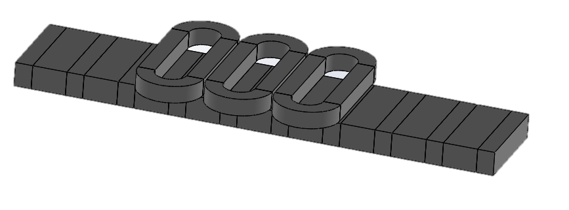Call Today: 916-259-1868

Linear motors do not use highly tooled constructions compared to rotary motors. Sierramotion configures linear motors quickly to the application requirements by changing the design before fabricating parts. Our modular production means the customer gets a customized solution within the standard lead time for a standard off the shelf system that may not fit.
Quick two-day design turn allows motor components to be reconfigured and matched to customer needs. Changes include force constant, resistance, and lead length. Complete customized designs that include mechanical size and magnetic design are also available.
Halbach magnet assemblies increase force by using additional adjacent magnets to the main magnet poles to focus flux through the motor coil. Halbach magnet array technology can also be used to eliminate iron from the linear motor reducing size and weight.
The selection of mechanical design and forcer potting materials can increase the stiffness of the structure. Higher stiffness will ultimately result in higher gain settings for fast response and fast settling.
Design building blocks are used to quickly compile a design. Historic magnetic models for each design block are stored and re-used, mechanical configuration is quickly done. Parts are ordered and assembled. This process can be as short at 6 weeks.
Standard mounting of the magnet track and coil assembly can be modified to match mating components. It is also possible to integrate customer frames and features into linear motor parts to reduce tolerances and reduce precision parts.
Depending on the type of integration, flying leads, cables or high flex cables can be designed into the moving forcer. Some applications require a cable tray and special machine/gantry high flex cabling, in this case a simple cable is better to run locally and join the cable tray to save cost and redundancy.
Sierramotion configures a linear motor directly for your project, in the time it takes to order and receive a standard product. Our modular design and modular manufacturing process allows this to be possible. Whether it is a new requirement or a replacement for a unit that is no longer available, the modular design process can quickly get you to a solution.
| Specifications | |
|---|---|
| Motor Width range | 10-50 mm |
| Motor Height range | 25-50 mm |
| Forcer Length | 50-350 mm |
| Voltage Range | 24-600 volts |
| Current Range | 5-25 amps |
| Force Output Range | 5-450 Newtons |
| Force Output Maximum (limited duty cycle) | 15-1350 Newtons |
Yes, most linear motors operate in position mode using a high resolution linear encoder. Position resolution down to 50 Nanometers is common.
Accuracy of the motor depends entirely on the encoder system used. The motor is a force production device. There are linear motors that operate using stepping motor controllers, it is only in this case where the motor can open loop position.
Yes, linear motors can produce a force to hold a vertical load, they can also apply force to an object. Care must be taken to not exceed the continuous force rating for the motor to avoid overheating.
Stiffness is dependent on the encoder resolution. With high resolution and a good servo control system, the motors are extremely stiff up to the rated force capability. Full force can be applied with 100 Nanometers of position error.
This is what they are best at doing. Linear motors are excellent at moving medium weight items (1-50kg) around at high speeds. Typical motors can move at 5-10 meters per second.
It depends on the type of motor. Air-Core linear motors have zero cogging and are the smoothest operating versions. Iron-Core linear motors have cogging which can cause vibration when moving.